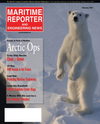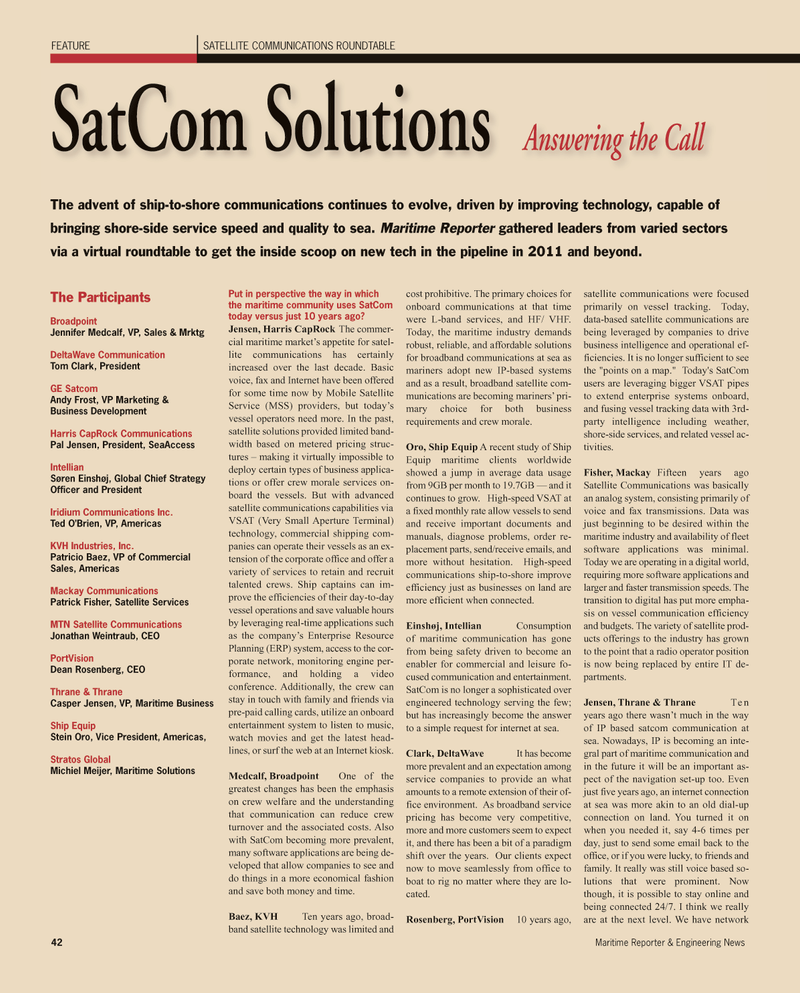
Page 42: of Maritime Reporter Magazine (February 2011)
Cruise & Passenger Vessel Annual
Read this page in Pdf, Flash or Html5 edition of February 2011 Maritime Reporter Magazine
Put in perspective the way in which the maritime community uses SatCom today versus just 10 years ago?
Jensen, Harris CapRock The commer- cial maritime market’s appetite for satel- lite communications has certainly increased over the last decade. Basic voice, fax and Internet have been offered for some time now by Mobile Satellite
Service (MSS) providers, but today’s vessel operators need more. In the past, satellite solutions provided limited band- width based on metered pricing struc- tures – making it virtually impossible to deploy certain types of business applica- tions or offer crew morale services on- board the vessels. But with advanced satellite communications capabilities via
VSAT (Very Small Aperture Terminal) technology, commercial shipping com- panies can operate their vessels as an ex- tension of the corporate office and offer a variety of services to retain and recruit talented crews. Ship captains can im- prove the efficiencies of their day-to-day vessel operations and save valuable hours by leveraging real-time applications such as the company’s Enterprise Resource
Planning (ERP) system, access to the cor- porate network, monitoring engine per- formance, and holding a video conference. Additionally, the crew can stay in touch with family and friends via pre-paid calling cards, utilize an onboard entertainment system to listen to music, watch movies and get the latest head- lines, or surf the web at an Internet kiosk.
Medcalf, Broadpoint One of the greatest changes has been the emphasis on crew welfare and the understanding that communication can reduce crew turnover and the associated costs. Also with SatCom becoming more prevalent, many software applications are being de- veloped that allow companies to see and do things in a more economical fashion and save both money and time.
Baez, KVH Ten years ago, broad- band satellite technology was limited and cost prohibitive. The primary choices for onboard communications at that time were L-band services, and HF/ VHF.
Today, the maritime industry demands robust, reliable, and affordable solutions for broadband communications at sea as mariners adopt new IP-based systems and as a result, broadband satellite com- munications are becoming mariners’ pri- mary choice for both business requirements and crew morale.
Oro, Ship Equip A recent study of Ship
Equip maritime clients worldwide showed a jump in average data usage from 9GB per month to 19.7GB — and it continues to grow. High-speed VSAT at a fixed monthly rate allow vessels to send and receive important documents and manuals, diagnose problems, order re- placement parts, send/receive emails, and more without hesitation. High-speed communications ship-to-shore improve efficiency just as businesses on land are more efficient when connected.
Einshøj, Intellian Consumption of maritime communication has gone from being safety driven to become an enabler for commercial and leisure fo- cused communication and entertainment.
SatCom is no longer a sophisticated over engineered technology serving the few; but has increasingly become the answer to a simple request for internet at sea.
Clark, DeltaWave It has become more prevalent and an expectation among service companies to provide an what amounts to a remote extension of their of- fice environment. As broadband service pricing has become very competitive, more and more customers seem to expect it, and there has been a bit of a paradigm shift over the years. Our clients expect now to move seamlessly from office to boat to rig no matter where they are lo- cated.
Rosenberg, PortVision 10 years ago, satellite communications were focused primarily on vessel tracking. Today, data-based satellite communications are being leveraged by companies to drive business intelligence and operational ef- ficiencies. It is no longer sufficient to see the "points on a map." Today's SatCom users are leveraging bigger VSAT pipes to extend enterprise systems onboard, and fusing vessel tracking data with 3rd- party intelligence including weather, shore-side services, and related vessel ac- tivities.
Fisher, Mackay Fifteen years ago
Satellite Communications was basically an analog system, consisting primarily of voice and fax transmissions. Data was just beginning to be desired within the maritime industry and availability of fleet software applications was minimal.
Today we are operating in a digital world, requiring more software applications and larger and faster transmission speeds. The transition to digital has put more empha- sis on vessel communication efficiency and budgets. The variety of satellite prod- ucts offerings to the industry has grown to the point that a radio operator position is now being replaced by entire IT de- partments.
Jensen, Thrane & Thrane Ten years ago there wasn’t much in the way of IP based satcom communication at sea. Nowadays, IP is becoming an inte- gral part of maritime communication and in the future it will be an important as- pect of the navigation set-up too. Even just five years ago, an internet connection at sea was more akin to an old dial-up connection on land. You turned it on when you needed it, say 4-6 times per day, just to send some email back to the office, or if you were lucky, to friends and family. It really was still voice based so- lutions that were prominent. Now though, it is possible to stay online and being connected 24/7. I think we really are at the next level. We have network 42 Maritime Reporter & Engineering News
FEATURE SATELLITE COMMUNICATIONS ROUNDTABLE
SatCom Solutions Answering the Call
The advent of ship-to-shore communications continues to evolve, driven by improving technology, capable of bringing shore-side service speed and quality to sea. Maritime Reporter gathered leaders from varied sectors via a virtual roundtable to get the inside scoop on new tech in the pipeline in 2011 and beyond.
The Participants
Broadpoint
Jennifer Medcalf, VP, Sales & Mrktg
DeltaWave Communication
Tom Clark, President
GE Satcom
Andy Frost, VP Marketing &
Business Development
Harris CapRock Communications
Pal Jensen, President, SeaAccess
Intellian
Søren Einshøj, Global Chief Strategy
Officer and President
Iridium Communications Inc.
Ted O’Brien, VP, Americas
KVH Industries, Inc.
Patricio Baez, VP of Commercial
Sales, Americas
Mackay Communications
Patrick Fisher, Satellite Services
MTN Satellite Communications
Jonathan Weintraub, CEO
PortVision
Dean Rosenberg, CEO
Thrane & Thrane
Casper Jensen, VP, Maritime Business
Ship Equip
Stein Oro, Vice President, Americas,
Stratos Global
Michiel Meijer, Maritime Solutions

 41
41

 43
43
